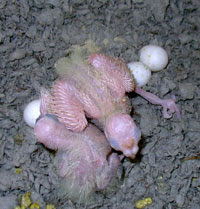Baby parrots are not cute. They are born naked (without feathers), blind and helpless. They require the care of their parents to survive. So, why would an adult Kea parrot reject its chick? Research has suggested that one of the reasons that birds reject their babies is that they are somehow deformed or defected, and probably wouldn't be able to survive by themselves.
 |
| Baby Cockatiels |
 |
| Nelson |
I'm not sure if the specialists at the Bergzoo in Halle Germany who are taking care of Nelson, the only chick to hatch and survive from a clutch of three eggs, know why his mother rejected him. The theory is that he is too ugly. I will admit that Nelson could probably take first prize in the ugliest bird contest, but I haven't seen pictures of any other baby Kea parrots that look any better. In fact, he looks pretty much the way a baby Kea parrot should. So, why did he get the cold wing?
 |
| Nelson being weighed |
According to: http://www.keaconservation.co.nz/keaendangeredspecies.html . For an endangered species, Kea are highly adaptive and are considered by scientists to be one of the most intelligent bird species in the world. They are e also the only alpine parrot species and now number an estimated 1000-5000 individuals in the wild. Numbers of Kea were substantially reduced with the introduction of a bounty, which resulted in over 150,000 birds being culled as late as the 1970’s (Temple, 1978).
 |
| Momma Kea feeding a fledgling |
Kea are highly gregarious, forming large social flocks in the wild with non-linear hierarchies. Once adult kea reach breeding age around 3-4 years of age they tend to leave the main flock and pair up for breeding and raising of chicks. Progeny have an extended juvenile period and are dependent on their parents for up to 6 months.
The Kea nests in burrows or crevices among the roots of trees, and are known for their intelligence and curiosity, both vital to their survival in a harsh mountain environment. Kea can solve logical puzzles, such as pushing and pulling things in a certain order to get to food, and will work together to achieve a certain objective.
 |
| I'm ready for my close-up now, Mr. DeMille |
This intelligence and curiosity has created difficulties with humans resulting in severe persecution of the species over the last 150 yrs. Now uncommon, the Kea was once killed for bounty due to concerns by the sheep farming community that it attacked livestock, especially sheep. It received full protection only in 1986.
For more information on what researchers have found out about kea, visit the University of Vienna's Kea Lab at http://cogbio.univie.ac.at/labs/kea-lab/
 |
| Nelson ready for dinner |
As for Nelson, he is being cared for round the clock by zoo staff, and despite his baby looks, he does have something to look forward too. Kea parrots grow up to have olive-green feathers with a beautiful orange flash under their wings. And Nelson is a smart little bird, so be careful what you say about him now because he just may remember and come back in full bloom to show you how wrong you were.
Interested in learning more about Nelson or the Kea? Check out any of the following links:


No comments:
Post a Comment
Thank you for making my day! Writers with any thoughts at all (Naughty or otherwise) love comments, and I'm no exception.